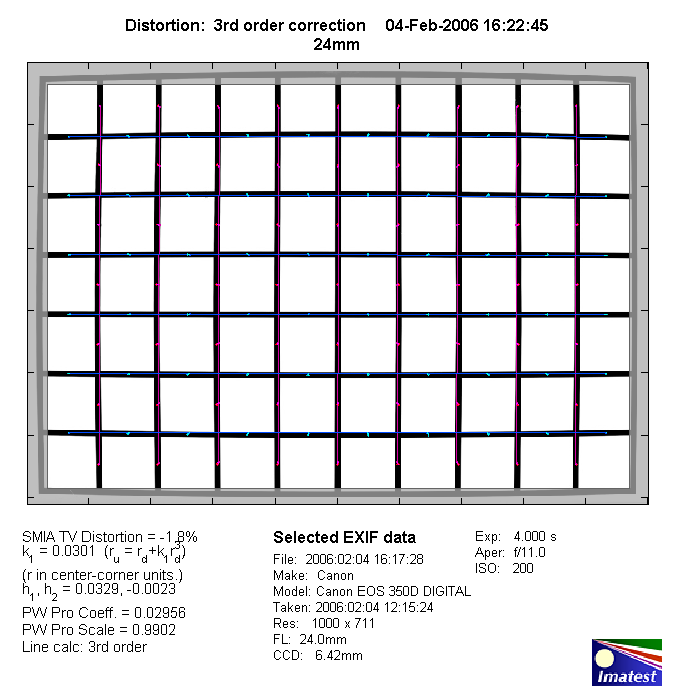|
Canon EF 24-105mm f/4 USM L IS - Retest @ 15mp (APS-C) - Analysis |
|
Lens Reviews -
Canon EOS (APS-C)
|
|
Page 2 of 2

Distortion
At 24mm the lens exhibits pronounced barrel distortion (1.8%) - this is significantly more compared to the EF 24-70mm f/2.8 USM L but it's still fairly moderate compared to the rest of the competition. There is slight pincushion distortion at longer focal lengths but this is nothing to worry about in most field conditions.
|
Move the mouse cursor over the focal length text marks below to observe the respective distortion
|
| 24mm |
40mm |
70mm |
105mm |
|

|
The chart above has a real-world size of about 120x80cm (taken from the initial review).
Vignetting
The lens can take advantage of the usual sweet spot when used on a smaller format - at wide-open aperture the vignetting does not exceed 0.6EV which is usually not much of an issue in real life situations. One stop down the problem is absolutely negligible.

MTF (resolution)
The EF 24-105mm L produced very decent resolution figures in the MTF lab. The center performance varies around very good to excellent results throughout the zoom range. The border quality is also very high at 24mm and 40mm. There's a penalty at 70mm and 105mm at max. aperture which is even more pronounced in the extreme corners (not shown here). However, the border quality improves when stopping down to f/5.6-f/8.
The lens alignment (centering) of the tested sample wasn't perfect at the long end of the range (still within test specifications) which may explain the border problems at f/4.
Please note that the MTF results are not directly comparable across the different systems!
Below is a simplified summary of the formal findings. The chart shows line widths per picture height (LW/PH) which can be taken as a measure for sharpness.
If you want to know more about the MTF50 figures you may check out the corresponding Imatest Explanations
Chromatic Aberrations
The degree of lateral chromatic aberrations (color shadows at harsh contrast transitions) is about average. They are most pronounced at the extreme ends of the range at around 1.5px - this can be visible at times but it's not a deal-breaker either. Lateral CAs are also easily correctable during post-processing (Canon's DPP does it for you for instance).
As mentioned the tested sample wasn't perfect which should explain some of the differences compared to the initial test of this lens based on the EOS 350D.

Bokeh (out-of-focus blur) @ 105mm
The Canon EF 24-105mm L is capable of producing a pleasing bokeh for a zoom lens. The circular out-of-focus highlights show a slight halo effect at 105mm f/4. Stopping down to f/5.6 reduces the effect but it's not overly worrisome anyway. The out-of-focus blur is very smooth and nothing to worry about (at 105mm). However, regarding its rather moderate max. aperture the 24-105mm L isn't really suitable for shallow depth-of-field applications.

The result has been copied from the full format test.
Verdict
The Canon EF 24-105mm f/4 USM L IS produced pretty good quality figures in our tests. The resolution is generally very high throughout the tested range with the exception of 70mm and 105mm @ f/4 where the border quality tanked somewhat - this may originate in a slight centering issue of our test sample which showed up at longer focal lengths. Typical for most full format lenses vignetting isn't really an issue when using the lens on an APS-C DSLR. Distortions are a bit more pronounced at 24mm but very low at other settings. Lateral CAs are on an average level. The bokeh (the quality of the out-of-focus blur) @ 105mm is good for a zoom lens. As to be expected from a modern Canon L lens the (outer) construction quality is up to pro standards. The AF is exceptionally fast, accurate and near silent. The image stabilizer works well within its specifications although some may miss a panning mode which is implemented in Canon's IS L tele lenses. The EF 24-105mm is a pricey lens within this scope - the EF-S 17-55mm f/2.8 USM IS is probably a better deal here.
|